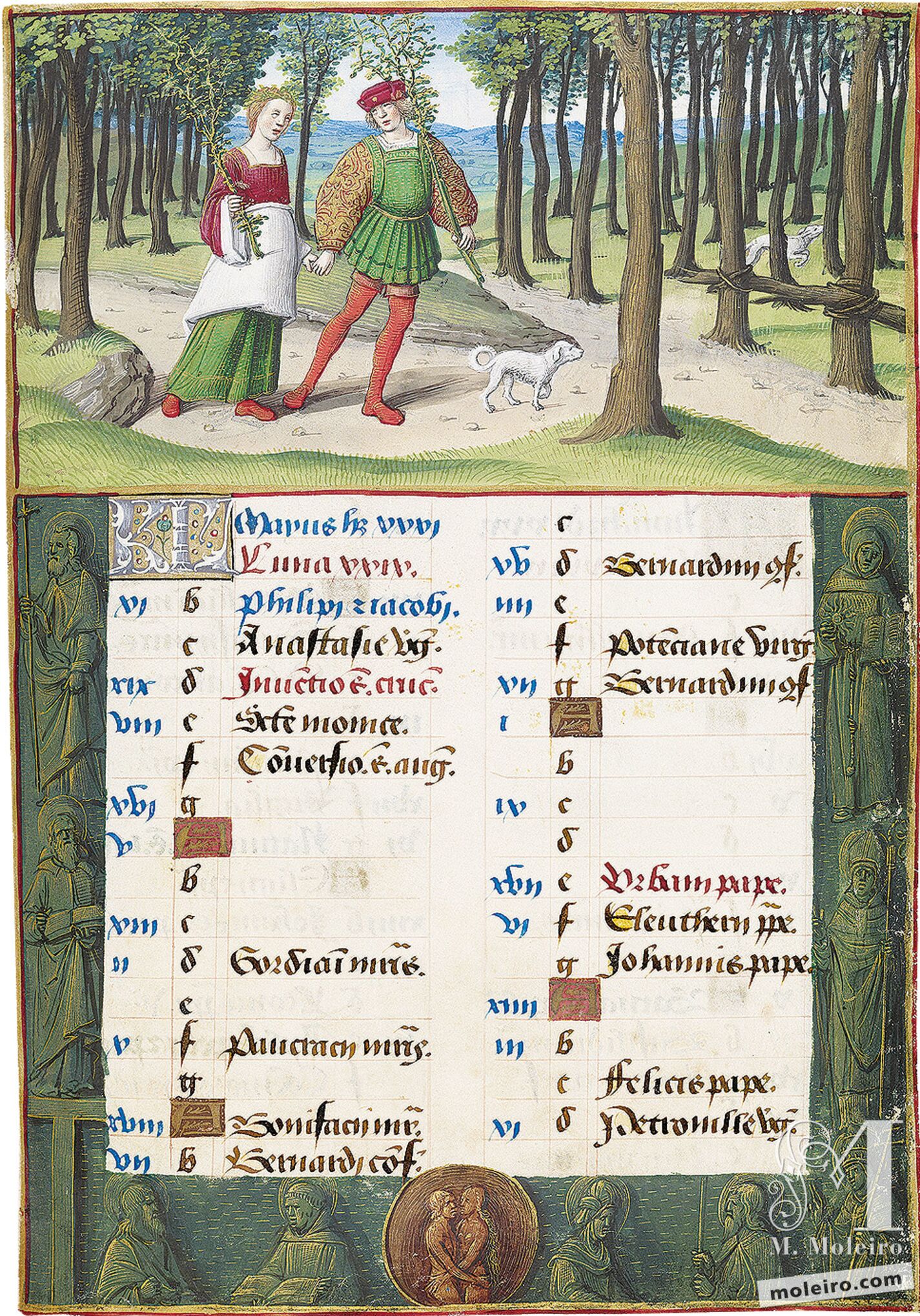Another leisurely couple performs May’s pleasure: the gathering, on the first day of the month, of flowering or leafing branches. The woman has pulled up the hem of her gown and tucked its train under her belt, making it easier and cooler to walk. Her neckline is squared in the Renaissance manner, like the girl in the April miniature. Her beau, too, is dressed in the latest Renaissance style. He wears a frock with voluminous embroidered Lombard sleeves. High boots, husen, reach to his mid-thigh, and, atop his head is a scarlet carmignolle.
In the left border are two apostles, Sts. Philip and James (May 1, in blue), one with a cross and the other with a book (rather generic attributes that do not help distinguish the two). The pair is followed by a tall Cross (for the Feast of the Finding of the True Cross on May 3, in red). Next is a generic male saint who probably refers to one of the three martyrs listed toward the bottom of the first column: Gordianus (May 10), Pancratius (May 12), or Boniface (May 14). The last saint in this section of the border, a monk, is probably the last listed in the column, Bernard (May 15). The right border begins with St. Bernardinus of Siena (the feast of the translation of his relics is on May 17; his regular feast is on May 20); dressed in the robes of a Franciscan, he holds a book and a round disk from which rays burst (the disk is usually inscribed with the holy monogram of Jesus, IHS). Next is a generic bishop or abbot saint. Following him is a pope saint who probably refers to Urban I (May 25, in red), while also alluding to the three other popes that also listed: Eleutherius (May 26), John I (May 27), and Felix I (May 30). The pope saint is followed by another generic male saint and, finally, the first-century Petronilla (May 31), wearing a knotted turban, a pictorial allusion to her antiquity.
The zodiacal sign is Gemini, the Twins (shown in a naked embrace).
Roger S. Wieck.
Another leisurely couple performs May’s pleasure: the gathering, on the first day of the month, of flowering or leafing branches. The woman has pulled up the hem of her gown and tucked its train under her belt, making it easier and cooler to walk. Her neckline is squared in the Renaissance manner, like the girl in the April miniature. Her beau, too, is dressed in the latest Renaissance style. He wears a frock with voluminous embroidered Lombard sleeves. High boots, husen, reach to his mid-thigh, and, atop his head is a scarlet carmignolle.
In the left border are two apostles, Sts. Philip and James (May 1, in blue), one with a cross and the other with a book (rather generic attributes that do not help distinguish the two). The pair is followed by a tall Cross (for the Feast of the Finding of the True Cross on May 3, in red). Next is a generic male saint who probably refers to one of the three martyrs listed toward the bottom of the first column: Gordianus (May 10), Pancratius (May 12), or Boniface (May 14). The last saint in this section of the border, a monk, is probably the last listed in the column, Bernard (May 15). The right border begins with St. Bernardinus of Siena (the feast of the translation of his relics is on May 17; his regular feast is on May 20); dressed in the robes of a Franciscan, he holds a book and a round disk from which rays burst (the disk is usually inscribed with the holy monogram of Jesus, IHS). Next is a generic bishop or abbot saint. Following him is a pope saint who probably refers to Urban I (May 25, in red), while also alluding to the three other popes that also listed: Eleutherius (May 26), John I (May 27), and Felix I (May 30). The pope saint is followed by another generic male saint and, finally, the first-century Petronilla (May 31), wearing a knotted turban, a pictorial allusion to her antiquity.
The zodiacal sign is Gemini, the Twins (shown in a naked embrace).
Roger S. Wieck.